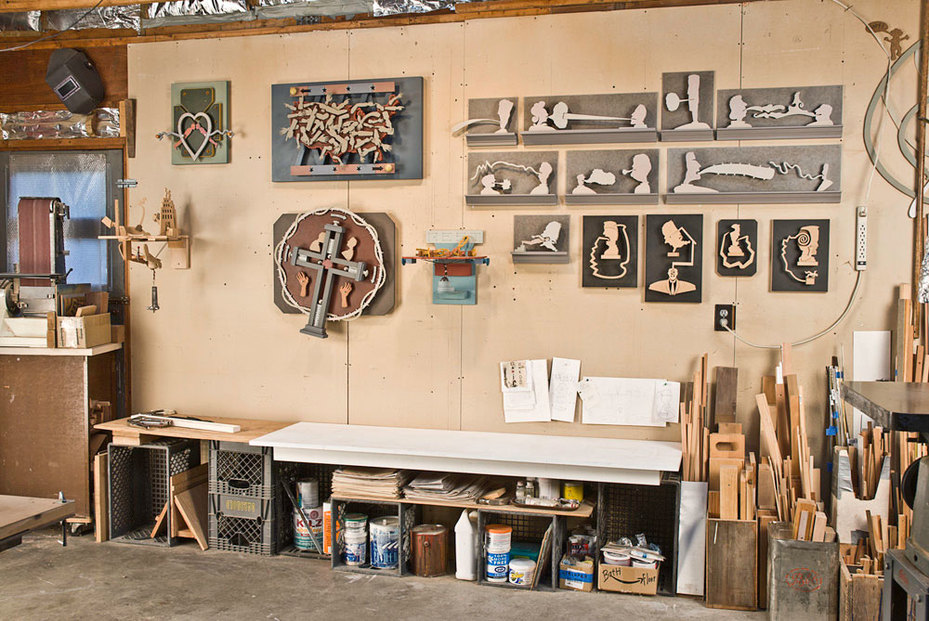2019 Show Statement
About the Work Groups 1-4
Since many of the pieces shown here are viewer activated, there are often alternative or detail images included which are intended to give an idea of the movement, different positions, and/or material depth. Dimensions are sometimes variable. The basic materials for the gallery sized work are hardboard (Masonite), fiberboard, wood, and several types of paint; plus miscellaneous other - such as bolts, brass rods, springs, string, knobs, lead weights, magnets, and steel balls.

STATEMENT 1974-2014
My work is fairly obvious—no tortured, art speak necessary. The materials are mostly available from your local lumber yard, the tools are low tech (the most faithful being a cast iron, Atlas jigsaw), the messages are conveyed with common, off-the-shelf symbols, and the movements are usually simple metaphors for the meanings.
In some of the work shown here, there's no motion involved, but most of my work is viewer activated, so there's the question: why the movement? Given the design challenges and technical difficulties inherent in the mechanics, doing art that moves can be tedious and slow. Generally I make a drawing, then a paper model, then a hot glued, fiberboard test model, and then the final piece, which usually needs further adjustment. And for the painting, I take everything apart, do the color, reassemble the pieces, and hope everything still moves as planned. But this process gets me going: experiment with some movement, do some problem solving, activate a concept, match form to function, and let the tactile elements bring up new ideas. The mechanics and movement sometimes suggest the subject matter, while at other times, they are improvised to complement a visual idea.
Craftsmanship is a basic element of the art. Although I struggle to work faster and looser (messier), I usually end up giving in to a self-imposed level of refinement, and tell myself that honoring craftsmanship in this digital age is OK. At any rate, I like to think that the way the pieces are cut out, fit together, balance, turn, or pivot gives the art a tactile quality which transmits the meaning to a non linear part of the brain, whether or not the art is actually manipulated.
BIO/RESUME
When I was a kid growing up in the fifties, art meant crayon and pencil on manilla paper, paint by numbers, and Jon Gnagy's Learn-To-Draw kit. I drew Red Sox ball players, World War II carrier warfare, and skunks (I had one as a pet). Inspired by Winslow Homer, I moved on to Maine Coast watercolors featuring waves, rocks, and derelict lobster boats.
Eventually, after earning a BFA in painting from the University of Washington, I launched my somewhat, sporadic career as a bona fide artist. In the early seventies my paintings gave way to gimmicky, mechanical constructions, a selection of which I sold at Northwest street fairs in 1974. Some decent solo shows in Seattle followed, starting with the and/or gallery in 1976, and going on to Rosco Louie, Traver Gallery, Esther Claypool Gallery, Room 104 Gallery, and Gallery 4Culture. My work has also been in numerous group shows in the region, including shows at the Museum of Northwest Art, COCA, the Bellevue Art Museum, Bumbershoot, the Henry Art Gallery, and the Seattle Art Museum. I've never shown in Paris, London, or Berlin.
Commissions include site specific, public art done for Seattle, King County, Washington State, and Metro (Seattle Transit Project); plus some miscellaneous private commissions—for a restaurant, a hotel, the Fort Worth Chamber of Commerce, a house in Maine, and more.
I've won some prizes, gotten some grants, and appeared in a few publications. My work is in the collections of the City of Seattle, King County, Washington State, the Seattle Art Museum, and various friends and non-acquaintances.
If you really want to see all the dates, titles, and proper nomenclature, which I think is not too exciting and shouldn't affect how you view my work, I can reluctantly provide the necessary details.